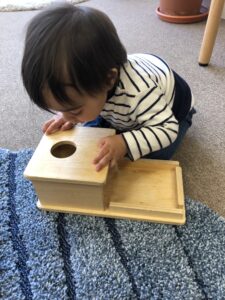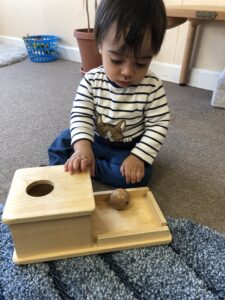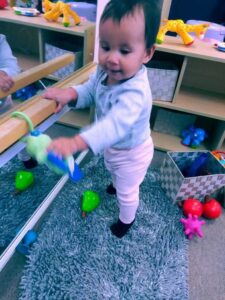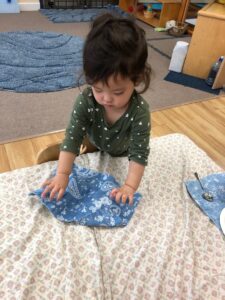
An Italian educator and scientist known for developing the Montessori Method currently used all around the world for teaching children of all ages, Dr. Maria Montessori wrote that the period between birth to age 3 is when your child’s brain develops more rapidly than at any other time, and more learning takes place than at any other stage of development.

The Montessori Nido Environment is designed with open spaces that incorporates high quality wooden furniture, and shelves. There is a lot of floor space with soft area rugs and pillows. There is some art on the walls placed at the child’s level.
The children sleep in Montessori floor beds and are able to move about as they wake up, never confined to a crib.

The Montessori guide holds your infant on her lap or in her arms to offer a bottle or food. Once your infant can sit up on her own, she will move to a chair at the table. The table and chair are at your child’s height. Different size chairs are available as your child grows. There are no hi-chairs, bouncy chairs or play pens.
In the Montessori Environment, care is taken not to overstimulate your infant. “Sensory Overload” happens when your young infant is flooded by more experiences, sensations, noise, and activity than the developing brain can cope with.
While sensory stimulation is an important way for your young infant to learn about themselves and the world around them, it is important to set up the environment and carry out activities without overstimulating her young mind.
At most daycare centers, there tends to be a lot of plastic toys that make a lot of noise, overstimulating the young child. Many have walls covered with bright colors, posters, and decals. The music is played loud just enough to drown out crying. The children sit in rows of hi-chairs to be fed.
Sometimes it is hard to tell how long a child might spend in a hi-chair and some are even left in the hi-chair as they fall asleep.
Infants at this young age cannot yet speak for themselves, it is important for you, as a parent to trust what is happening with your baby while in childcare.
In the MSOSV Nido environment, infants are either in the arms of the guide or they are free to move in and out of bed, from the table and never in a play pen.
Parents can rest assured that your infant will never be left in a confined space longer than appropriate.

The Montessori “work-time” is typically 1.5 to 2.5 hours at a time, allowing children to freely choose what they would like to do.
For example, many activities are available at child-level shelves. Some of these activities rotate and some remain constant.
One of the Nido guides will have a group activity going on during the work period, the children are free to join and stay as long as they like. While another child can choose an activity from the shelf.
Cooperative behavior – when finished with an activity, the children learn to put it back before taking out another activity. The children know they can work on an activity if a friend is not using it. Learning to wait for a turn is an important skill, this starts as young as 12 months.
We take our time. The children are allowed ample time to make transitions. When it is time to go outside, plenty of time is planned to put on their coat, shoes and prepare to go outside. Around age 1, the children begin to set up and clean up their eating space. Again, plenty of time is allowed for this activity. There is never a reason to rush, allowing the children the time they need to do the work. The children really enjoy these activities and consistency is key.
It may be messy, but as soon as your infant can grasp a spoon, the guides encourage your child to feed herself. The guides assist a bit, but mostly leave the work up to your child, gently encouraging.
Using a very tiny pitcher, the guide will pour the milk or water. Your child can use the pitcher to pour milk or water into her own cup. The Nido children transition to a cup as soon as they are sitting at the table on their own. The children love pouring their own milk and then drinking it. Yes, sometimes there are spills – that’s ok – and why we use the small pitcher as the control.
Typical daycare centers have adult-set schedules where children are moved into a new activity every 20-40 minutes. Children must move as a group to the next activity whether they are ready or not. Instructions happen in a group setting at the adult-led pace, even if some children move faster or slower.
Generally, the adults in the environment do the tasks that the children can do, however, there are so many different transitions, the time is typically rushed. Putting on their coat, shoes and hats. Sitting the children in a hi-chair and spoon feeding etc. The children do not participate much, other than to be fed and dressed.

Freedom to explore at own pace – your infant is “on demand”, we follow each child individually. Up to 12 months of age, infants are all “on-demand”. Our guides follow your child and your routine at home. As your child grows and develops, our guides work close with you to adjust and build a routine based on consistency. Our online record-keeping system keeps you informed daily.
Once children reach the age of 12 months (approximately) they begin to fall into the daily routine and schedule with their friends of the same age. As stated above, the children are allowed plenty of time to carry out their activities, which much of the time involves “care of self”. The activities they LOVE at this age.

Typical daycare centers have cribs, highchairs, play pens and other items that “confine” children. The day is packed with transitions, moving the children from here to there. Time is not available for children to practice “care of self” and work towards independence.
The MSOSV Nido Community supports the various stages of building independence from this very young age through Kindergarten. These years mark a critical time for self-discovery.
Children can choose their own activities and discover them at their own pace. Instruction from the guide happens on a one-to-one basis where the guide gives a lesson to one child at a time.
After the lesson, the child is free to work on that activity until ready to move on to the next. The Montessori Learning Materials have a sequence, where concepts are introduced and scaffolded in.
The Montessori Guide helps to lead the children through the sequence. It is a very natural process.
Covered in the Montessori Nido:
Self-care – wash, dress, toilet and eating, according to each individual child capability
Care of the environment- cleaning, food prep, plant care
Large motor activities -inside and outside, walking climbing, running, balancing,
Fine motor skills – reaching, grasping, picking up objects, tracking, transferring, art
Language – naming, describing, conversation, singing and story telling
Sign Language is introduced to all Nido children and helps your child to express her needs, many times without tears
Social skills – developing manners through interactions with peers, adult led small groups

MSOSV Nido guides rotate duties each day
This allows the children and the staff to get to know each other, in the event one of the guides is out for the day, the day is not disrupted.
All the guides participate in all the duties, diapering, toilet learning, food prep, eating and time on the floor with the small group activities or individual work time.
This allows all the guides in the environment to make observations and catch anything that might be amiss.
As a parent, you are trusting us to give our very best and speak for your child, who cannot yet speak for themselves.
As you had read above, the prepared environment is specifically designed to stimulate the children appropriately. The calm way in which the Nido guides care for the children create an environment of peace and tranquility, optimal for learning and growing.
Typical daycare centers have “Primary Caregivers”. Each caregiver is assigned a small group of children. That caregiver solely cares for their group of children. When this caregiver is absent from daycare, someone else will step in.
Many times, the children might not be familiar with this person, thus creating room for a difficult day for your child.
Getting to know every guide in the community not only helps your child to trust others, you can have peace of mind that your child is having a good day.

Related links:
www.amshq.org/About-Montessori/Inside-the-Montessori-Classroom/Infant-and-Toddler
Www.activebabiessmartkids.com.au/articles/baby-risk-sensory-overstimulation/?v=322b26af01d5
https://www.themontessorinotebook.com/montessori-for-babies/